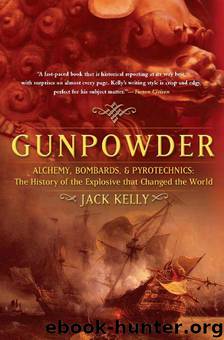Gunpowder by Jack Kelly

Author:Jack Kelly
Language: eng
Format: epub, pdf
Publisher: Basic Books
Published: 2012-01-30T16:00:00+00:00
9
WHAT VICTORY COSTS
EVEN AS GUNPOWDER was ratcheting the violence of organized warfare to unprecedented levels, it continued to offer thinkers perplexing and intriguing problems. “Ultimately it was the effects of gunpowder on science rather than on warfare that were to have the greatest influence in bringing about the Machine Age,” wrote historian J. D. Bernal. “Gunpowder and cannon not only blew up the medieval world economically and politically; they were major forces in destroying its system of ideas.”
Beginning in the sixteenth century, gunpowder began to focus the attention of Europe’s natural philosophers not only on the mystery of fire and the composition of the material world, but also on questions of mechanics and the forces and laws of motion. For example, both gunners and natural philosophers wanted to know: What happens to the cannonball after it leaves the barrel of the gun? The search for a definitive answer took four hundred years and required the creation of entirely new fields of science.
Gunners did have some notion about what drove the ball out of the gun. Vannoccio Biringuccio summed it up in 1540: Fire, he thought, took up ten times as much room as air, air ten times as much as water, water ten times as much as earth. So when the earthy powder changed to fire, air, and moist smoke, these elements instantly expanded, pushing the projectile before them. While based on a fanciful theory, his idea roughly summed up what was happening. Burning powder changed to a hot gas of vastly larger volume. The gas exerted pressure on the ball.
But why did the ball keep moving after it emerged? What path did it follow? And what did that path reveal about the forces acting on the projectile and on all objects? The first man to address these questions was a contemporary of Biringuccio named Niccolò Tartaglia. Niccolò was born in the northern Italian town of Brescia in 1500, the son of a mail courier. His father died when the boy was six, leaving his family in poverty even as wars ripped across the country. At the age of twelve Niccolò was caught up amidst rampaging French troops. A soldier slashed his sword across the boy’s face, lacerating his mouth and palate. Niccolò’s mother nursed him back to health, but he carried through life a severe disfigurement and speech defect. He gave himself the name Tartaglia, from the Italian word for stutter. His original surname is lost to history.
Once healed, the teenager went to Master Francesco to begin learning the alphabet. He had only reached the letter K before his meager funds ran out. He achieved all the rest of his learning on his own, “accompanied,” he later wrote, “by the daughter of poverty that is called industry.” He found in himself an affinity for mathematics and was soon in Verona teaching students to use the abacus. Later he became a professor of math at Venice, still barely making enough to support his family.
Seventeenth-century ideas about the motion of cannonballs
Download
This site does not store any files on its server. We only index and link to content provided by other sites. Please contact the content providers to delete copyright contents if any and email us, we'll remove relevant links or contents immediately.
Learning SQL by Alan Beaulieu(6209)
Weapons of Math Destruction by Cathy O'Neil(6142)
Digital Minimalism by Cal Newport;(5662)
iGen by Jean M. Twenge(5366)
Sapiens by Yuval Noah Harari(5293)
The Age of Surveillance Capitalism by Shoshana Zuboff(4209)
Elon Musk by Ashlee Vance(4027)
Thing Explainer by Randall Munroe(3876)
Apollo 8 by Jeffrey Kluger(3635)
Future Crimes by Marc Goodman(3529)
The Science Book (Big Ideas Simply Explained) by DK(3233)
Who Can You Trust? by Rachel Botsman(3086)
Infinite Energy Technologies by Finley Eversole(2938)
I Live in the Future & Here's How It Works by Nick Bilton(2934)
Steve Jobs by Walter Isaacson(2830)
The Innovators: How a Group of Hackers, Geniuses, and Geeks Created the Digital Revolution by Walter Isaacson(2827)
Dawn of the New Everything by Jaron Lanier(2737)
Chernobyl by Serhii Plokhy(2496)
Ben Franklin's Almanac by Candace Fleming(2464)
